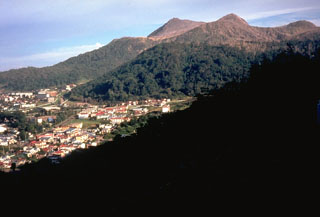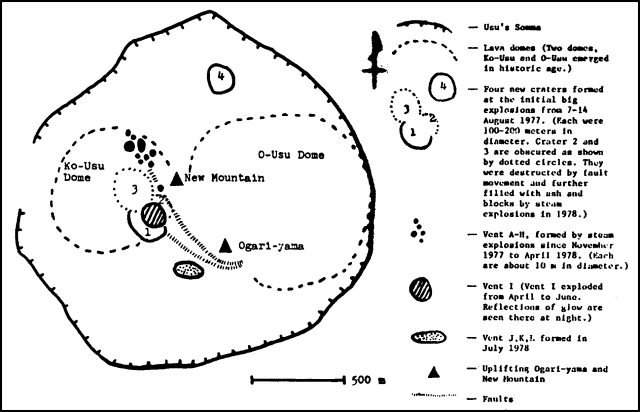Report on Toya (Japan) — August 1978
Scientific Event Alert Network Bulletin, vol. 3, no. 8 (August 1978)
Managing Editor: David Squires.
Toya (Japan) Steam explosions and glow; trends of declining seismicity and slower uplift continue
Please cite this report as:
Global Volcanism Program, 1978. Report on Toya (Japan) (Squires, D., ed.). Scientific Event Alert Network Bulletin, 3:8. Smithsonian Institution. https://doi.org/10.5479/si.GVP.SEAN197808-285030
Toya
Japan
42.544°N, 140.839°E; summit elev. 733 m
All times are local (unless otherwise noted)
Steam explosions continued, occurring on 2, 9, 10, 15-17, 25, and 28-31 July. The 15 July explosions deposited 10 mm of ash on nearby villages, the largest ashfall since November 1977. Vent I (figure 10), site of explosions in April, late May, and June became quiescent, but reflected glow could be seen above this area at night in June and July. Vents J, K, and L (about 300 m SE of vent I) were formed by explosions on 9, 15, and 16 July, respectively. Vigorous steam emission accompanied by continuous tremor enlarged the vents.
Mean daily seismicity fell to 175 events, of which an average of 23/day were felt. Uplift rates at . . . the new cryptodome ENE of Ko-Usu continued to decrease. . . . Subsidence of Ko-Usu dome has virtually ceased.
The Kyodo broadcasting company reported an explosion of Usu at 0325 on 24 August. The ash cloud rose about 800 m and ash fell on Noboribetsu, about 30 km from Usu. Shortly after the explosion, glow was seen above the summit for several minutes. An increase in local seismicity occurred 2 days before the explosion; 345 events were recorded 22 August, but only 102 on the 23rd.
Geological Summary. Usuzan, one of Hokkaido's most well-known volcanoes, is a small stratovolcano located astride the southern topographic rim of the 110,000-year-old Toya caldera. The center of the 10-km-wide, lake-filled caldera contains Nakajima, a group of forested Pleistocene andesitic lava domes. The summit of the basaltic-to-andesitic edifice of Usu is cut by a somma formed about 20-30,000 years ago when collapse of the volcano produced a debris avalanche that reached the sea. Dacitic domes erupted along two NW-SE-trending lines fill and flank the summit caldera. Three of these domes, O-Usu, Ko-Usu and Showashinzan, along with seven crypto-domes, were erupted during historical time. The 1663 eruption of Usu was one of the largest in Hokkaido during historical time. The war-time growth of Showashinzan from 1943-45 was painstakingly documented by the local postmaster, who created the first detailed record of growth of a lava dome.
Information Contacts: JMA, Tokyo; I. Yokoyama and Y. Katsui, Hokkaido Univ.; Kyodo broadcasting company.


